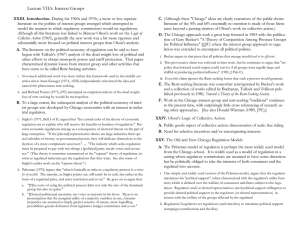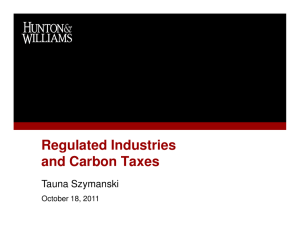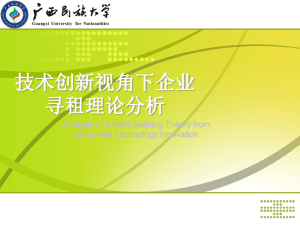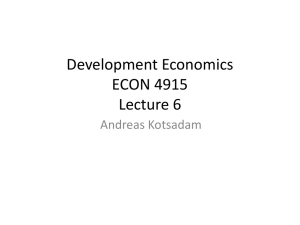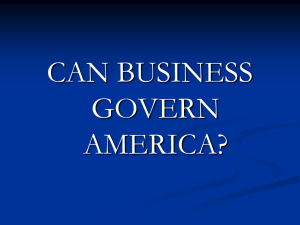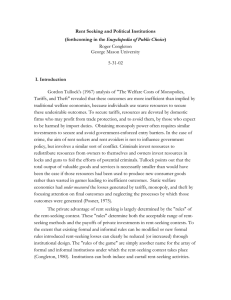I. Introduction (Overview of another rational choice literature on
advertisement
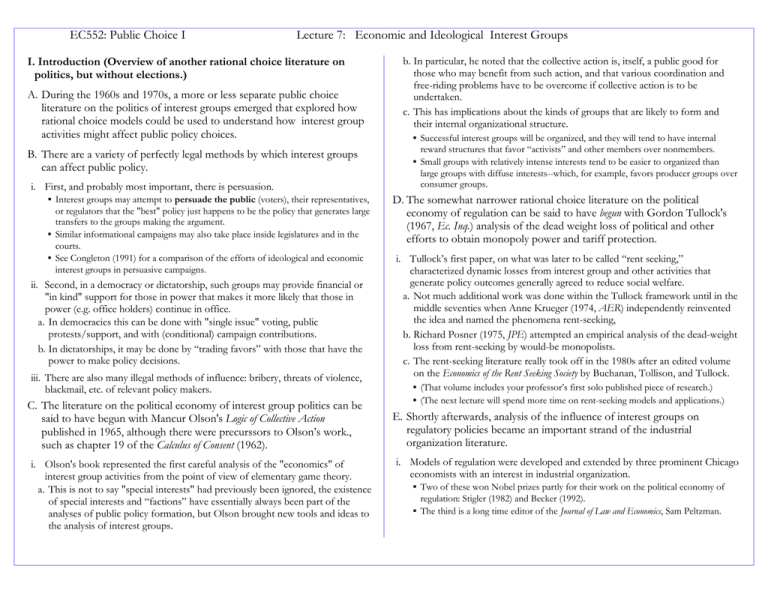
EC552: Public Choice I Lecture 7: Economic and Ideological Interest Groups I. Introduction (Overview of another rational choice literature on politics, but without elections.) A. During the 1960s and 1970s, a more or less separate public choice literature on the politics of interest groups emerged that explored how rational choice models could be used to understand how interest group activities might affect public policy choices. B. There are a variety of perfectly legal methods by which interest groups can affect public policy. i. First, and probably most important, there is persuasion. P Interest groups may attempt to persuade the public (voters), their representatives, or regulators that the "best" policy just happens to be the policy that generates large transfers to the groups making the argument. P Similar informational campaigns may also take place inside legislatures and in the courts. P See Congleton (1991) for a comparison of the efforts of ideological and economic interest groups in persuasive campaigns. ii. Second, in a democracy or dictatorship, such groups may provide financial or "in kind" support for those in power that makes it more likely that those in power (e.g. office holders) continue in office. a. In democracies this can be done with "single issue" voting, public protests/support, and with (conditional) campaign contributions. b. In dictatorships, it may be done by “trading favors” with those that have the power to make policy decisions. iii. There are also many illegal methods of influence: bribery, threats of violence, blackmail, etc. of relevant policy makers. C. The literature on the political economy of interest group politics can be said to have begun with Mancur Olson's Logic of Collective Action published in 1965, although there were precurssors to Olson’s work., such as chapter 19 of the Calculus of Consent (1962). i. Olson's book represented the first careful analysis of the "economics" of interest group activities from the point of view of elementary game theory. a. This is not to say "special interests" had previously been ignored, the existence of special interests and “factions” have essentially always been part of the analyses of public policy formation, but Olson brought new tools and ideas to the analysis of interest groups. b. In particular, he noted that the collective action is, itself, a public good for those who may benefit from such action, and that various coordination and free-riding problems have to be overcome if collective action is to be undertaken. c. This has implications about the kinds of groups that are likely to form and their internal organizational structure. P Successful interest groups will be organized, and they will tend to have internal reward structures that favor “activists” and other members over nonmembers. P Small groups with relatively intense interests tend to be easier to organized than large groups with diffuse interests--which, for example, favors producer groups over consumer groups. D. The somewhat narrower rational choice literature on the political economy of regulation can be said to have begun with Gordon Tullock's (1967, Ec. Inq.) analysis of the dead weight loss of political and other efforts to obtain monopoly power and tariff protection. i. Tullock’s first paper, on what was later to be called “rent seeking,” characterized dynamic losses from interest group and other activities that generate policy outcomes generally agreed to reduce social welfare. a. Not much additional work was done within the Tullock framework until in the middle seventies when Anne Krueger (1974, AER) independently reinvented the idea and named the phenomena rent-seeking, b. Richard Posner (1975, JPE) attempted an empirical analysis of the dead-weight loss from rent-seeking by would-be monopolists. c. The rent-seeking literature really took off in the 1980s after an edited volume on the Economics of the Rent Seeking Society by Buchanan, Tollison, and Tullock. P (That volume includes your professor’s first solo published piece of research.) P (The next lecture will spend more time on rent-seeking models and applications.) E. Shortly afterwards, analysis of the influence of interest groups on regulatory policies became an important strand of the industrial organization literature. i. Models of regulation were developed and extended by three prominent Chicago economists with an interest in industrial organization. P Two of these won Nobel prizes partly for their work on the political economy of regulation: Stigler (1982) and Becker (1992). P The third is a long time editor of the Journal of Law and Economics, Sam Peltzman. EC552: Public Choice I Lecture 7: Economic and Ideological Interest Groups P Essentially, these scholars applied Olson’s analysis of interest groups in general to to model economic regulation, which has long been an important topic in industrial organization. ii. Although this new “Chicago political economy” literature was linked to Mancur Olson's work on the Logic of Collective Action (1965), the new work was generally more rigorous, and more narrowly focused on US regulatory institutions and on politically active economic interest groups than Olson's analysis. P Unfortunately, the "Chicago political economy” neglected the public choice literature of the 50's and 60's. P Essentially no mention is made of the public choice literature beyond a passing citation of Olson's work on collective action. P (Such a pattern of citation, could be an example of academic rent-seeking, which many in the VA political economy circles took offense at, as they later take offense of the new political economy literature.) F. More recent innovations in the interest group literature include: i. a large series of papers inspired by Grossman and Helpman (1994, AER, “Protection for Sale”), which uses an auction model of interest group politics, in which rival groups bid for trade protections of one kind or another P The model is very similar in spirit to the Peltzman model discussed below and will be discussed in the lecture on rent seeking. ii. a smaller series of papers on rent-extraction inspired by McChesney (1987) in which he argues that politicians actively develop rent-seeking games as a method of “extracting” rents from firms and other interest groups iii. and an ongoing series of extension of the rent-seeking literature, most of which have been mathematical in nature (Congleton, Hillman, and Konrad 2008). G. A nice introductory survey of the literature before 1990 is provided by Munger and Mitchell (1991, APSR), which parallels in many respect that developed in this lecture, but with a greater focus on the political science literature and its approach to interest group analysis. II. Olson's Logic of Collective Action (1965) A. Although it may be argued that many of the ideas contained in the Logic of Collective Action were in the "air" at the time the book was written, Olson's book stands out as a very readable, original, and impressive analysis of the problems of organizing collective action. P (It was essentially his Ph. D. dissertation at Harvard.) i. The book deals with collective action in general, although for the purposes of this part of the course, its implications for politically active groups are most relevant. P Any activity involving more than a single person can be regarded as collective action. P These groups all have to solve a variety of free rider and coordination problems if they are to “productive enterprises.” P In many cases, to over comes such problems they will have to be organized--that is to say they will have internal incentive and decision making systems. ii. With respect to political activity, Olson notes that any efforts to influence policy via coordinated voting, lobbying, campaign contributions, etc. are all public goods for group members and so subject to the usual free rider problems. P That is to say, all members of the interest group (say farmers) benefit whether they have contributed to the collective effort to affect policy or not, when a policy is "improved" (as farmers might consider increases in farm subsidies). iii. [Illustrations of the free rider problem] P [Figure: the private marginal costs and benefits of collective action for an individual relative to that generated for other persons with similar interests.] P [Game Matrix of the free rider problem of organizing an interest group.] iv. In Olson’s analysis, overcoming the public goods and/or free rider problems are the most important impediments to collective action. B. Olson argues that small groups of persons or corporations with relatively intense or large interests in policy are more able to organize than large groups whose members have relatively small interests at stake. i. Small groups may therefore be able to exploit larger groups. P That is to say, small politically active groups they may be able to get preferential government policies adopted which benefit themselves at the expense of other larger groups in society. P [ Note that rational ignorance must play a role in the adoption of such policies in a democracy. Why? ] ii. Moreover, the benefits received by the small group may be less than the cost imposed on the large unorganized or poorly organized group. iii. In addition to group size and the intensity of individual member interests, Olson notes that various techniques can be used to overcome the organizational problems of large and small groups. EC552: Public Choice I Lecture 7: Economic and Ideological Interest Groups P For example, most politically active groups provide benefits of some kind that are directly related to membership. P That is to say, if it is possible to exclude non-members from at least some of the group's beneficial activities, there will be stronger incentives to join, and weaker incentives to free ride. iv. Olson calls such devices: selective incentives. P Thus farm coops provide many services to their members, in addition to lobbying for preferential farm policies. P Environmental and senior citizen groups often sponsor trips, newsletters, and so forth, in addition to lobbying for social security and medicare increases, etc.. v. Thought questions: P Name several groups that appear to be effective at influencing public policy. P What methods do they use to influence policy choices? P Does the general flow of direct and indirect transfers resemble that implied by Olson's analysis? P Is free-riding by potential interest group members necessarily a social problem in this case from the point of view of the Pareto criteria? P What is the optimal size of an interest group? III. Chicago Political Economy A. George Stigler’s (1971, Bell Journal of Economics) piece on the theory of economic regulation begins with: “The state--the machinery and power of the state--is a potential resource or threat to every industry in the society. With it s power to prohibit or compel, to take or give money, the state can and does selectively help or hurt a vast number of industries ... The central tasks of the theory of economic regulation are to explain who will receive the benefits or burdens of regulation, what form regulation will take, and the effects of regulation upon the allocation of resources. Regulation may be actively sought by an industry or it may be thrust upon it. A central thesis of this paper is that, as a rule, regulation is acquired by the industry and is designed and operated primarily for its benefit.” i. Stigler argued that what appear to be perverse economic regulations emerge as a consequence of economics advantages for large enterprises and (implicit) threats made by such enterprises to regulators and politicians. “If the [elected] representative denies ten large industries their special subsidies of money or governmental power, they will dedicate themselves to the election of a more complaisant successor.” “... The industry which seeks regulation must be prepared to pay with two things a [political] party needs: votes and resources.” “ ... We can only make plausible conjectures such as that the more concentrated the industry, the more resources it can invest in the campaign for legislation.” ii. Stigler’s economic theory of regulation is sometime referred to as the “capture theory” of regulation, because it concludes that regulated industries get the regulations that they want, rather than those that advance consumer or general interests. P (Note that not only do firms have advantages over consumers, but large firms also have advantages over small firms.) a. Stigler’s analysis includes numerous fairly detailed examples from the petroleum industry, the trucking industry, and occupational licensing (e.g. occupational entry barriers). b. Stigler also analyzes why such regulations might be adopted in representative democracies, although this is a minor part of the paper. P He argues that voters do not vote on issues one at a time, but rather have to vote on a number of policy issues (candidate platforms) simultaneously. P If both candidates support perverse regulations in order to gain the support of a particular industry (or to avoid its opposition), voters will not see their best policy options on the ballot (or party platforms). c. He also addresses the extent to which political parties might be limited in their ability to extort kickbacks and the like from industries, arguing that competition among political parties (potential entry) tends to prevent this from occurring. B. Peltzman (1976, Journal of Law and Economics) extends Stigler's analysis in his “Towards a More General Theory of Regulation). i. Peltzman clarifies, extends, and formalizes the Stigler model. a. Peltzman argues that: “the size of the dominant group is limited in the first instance by the absence of something like ordinary market-dollar voting in politics. Voting is infrequent and concerned with a package of issues. In the case of a particular issue, the voter must spend resources to inform himself about its implications for his wealth and which EC552: Public Choice I Lecture 7: Economic and Ideological Interest Groups politician is likely to stand on which side of the issue. That information cost will have to offset prospective gains, and a voter with a small per capita stake will not, therefore, incur it.” P [This implicitly challenges William Riker’s theory of the minimum winning coalition, which suggests that coalitions motivated by transfers and many other policy objectives should be as small as possible (50%+e] to maximize rewards to group members.] “A second major limit on the effective group size arises from costs of organization. It is not enough for the successful group to recognize its interests; it must organize to translate this interest into support for the politician who will implement it. This means not only mobilizing its own vote, but contributing resources to the support of the appropriate political party or policy.” iv. The most widely-used version of the Pelzman model simply assumes that the regulator (or politician) maximizes his "political support" (often characterized with the regulator's utility function) which is defined over the welfare of consumers and firms subject to the regulation. “while there may be some economies of scale in the organization of support and neutralization of opposition, these must be limited. ... The cost of lobbying and compagning willl rise faster than group size. The cost of overcoming “free riders” will also rise faster than group size. This diseconomy of scale in providing resources acts as another limit to the size of the group that will ultimately dominate the political process.” "what is basically at stake in a regulatory process is a transfer of wealth.” ii. The Peltzman (1976) model of regulation is probably the most widely used model from the Chicago school. a. The transfer, as Stigler had pointed out, “will rarely be in cash, but rather in the form of a regulated price, and entry restriction and so on.” Peltzman goes on to argue that: "[T]he costs of using the political process limit not only the size of the dominant group but also its gains." "[Elected politicians] maximize net votes or majority in his favor. There is no presumption that the marginal utility of a majority vanishes at one...Greater majorities are assumed to imply greater security of tenure, more logrolling possibilities greater deference from legislative budget committees and so on." iii. In his model, politicians maximize the size of their majorities M = nf - (N-n)h P where M is the size of the majority, nf is the expected support of the beneficiaries of a regulation (n = number of potential voters, and f the probability they turn out and vote for ( support) this politician.) P (N-n) is the number of persons who do not benefit, and h is the probability that those who do not benefit support his opponent or simply oppose this politicians election to office. P Regulators and/or elected representatives need political support willingness to provide desired political support to the regulators (or elected representatives) increases with the welfare of the groups affected by the regulated. P Regulators/Legislators set regulations (and transfers) to maximize political support (campaign contributions and the like). P He goes on to develop a careful mathematical model and examine comparative statics--not all of which can be unambiguously determined. v. Consider for example a regulator’s decision to set some price, P. a. Let “support” be characterized as: S = Σi Si(P) b. Differentiating with respect to P we find that the rational support mazimizer Σi SiP = 0 , where Sip is the derivative of person i’s will set P set such that support with respect to P. c. This first order condition (f. o.c.) implies that the regulated price, P, is set (raised or reduced) so that the marginal reduction in support from those favoring lower prices equals the marginal increase in support from those favoring higher prices. P In cases where the policy variable is a vector and many different groups are affected by that policy, all of these interests--as expressed with promises of “support”--are balanced against each other at the margin. P There is no “winner take all” or complete capture result as in the Stigler model. P Rather, the organizational advantages of industry allow them to partially capture the regulatory process, because their political support will be more sharply affected by marginal changes in regulations than that of consumers. d. The support functions are very similar to probabilistic voting functions in which expected votes increases or decrease with the policy positions. P In this respect, the Peltzman model is compatible with the results of that portion of the electoral public choice literature. EC552: Public Choice I Lecture 7: Economic and Ideological Interest Groups P However, it is clear that Peltzman want to consider all “support,” not simply votes, although he wants to treat that support in much the same manner as voting is treated in probabilistic voting models. P That is, it is total support that determines winners and losers, and the size of one’s margin of victory. P As in probabilistic voting models, individual voters and organized interest groups are given more or less weight by politicians according to how much their “support” is affected by small shifts in policies. P (Probabilistic voting models that were developed at about the same time include Intriligator (1973) and Nitzan (1975), although none are cited.) e. In the usual Peltzman inspired analysis, not much attention is given to electoral constraints faced by the regulator, his incentives to pay attention to lobbyists, or the public goods incentives of groups that might affect their ability to lobby for regulatory preference. P Peltzman and Stigler, however, give more attention to elections and electoral pressures than most persons subsequently using their models do, although elections are clearly not the main focus of their analysis. P The focus of their analyses tend to be how a regulated industry reacts to proposals of the regulator (by making larger or smaller campaign contributions or providing other sorts of support). vi. Peltzman’s model differs from the Stigler model in that it assumes that the regulatory commissions is politically obliged to take the interests of both consumers and the regulated into account. P Both firms and consumers can be sources of support. P Thus, the interests of both firms and consumers affect the regulation adopted. P However, the support from voters will rarely be organized and so generate less support or opposition at the margin for small changes in regulations. vii. [Perhaps surprisingly, the interest group models of regulatory capture (and partial capture) helped to motivate a wave of deregulation in the late 1970s and early 1980s.] a. They helped to undercut the normative support for such regulations, by directing attention to the perverse politics of regulation (e.g. the possibility of “government failure” from the perspective of mainstream welfare analysis). P (Many more mainstream I.O. persons, such as Kahn 1971, had reached similar conclusions about the relative merits of regulation and market competition.) P As a consequence, a number of industries (especially those involved in transportation) were deregulated in the late 1970s and early 1980s in the US, and in Europe. b. [Why is deregulation surprising, given their analysis?] C. In 1983 (Quarterly Journal of Economics), Becker developed a model that essentially overturned many of the normative implication of the Stigler and Peltzman models. Political influence is not simply fixed by the political process, but can be expanded by expenditures of time and money on campaign contributions, political advertising, and in other ways that exert political pressure. Political equilibrium has the property that all groups maximize their incomes by spending their optimal amount on political pressure, given the productivity of their expenditures, and the behavior of other groups. i. Becker’s model is similar in spirit to the Peltzman model, except that the model has no obvious regulatory policy maker, and it attempts to characterize a general equilibrium among competing interest groups. P The policymaking process and institutions are essentially left to the reader’s imagination. P To the extent to which there is any voting going on, it is left in a very abstract and continuous form. a. He concludes that regulatory contests among interest groups tend to produce economically efficient public policies. That is to say, both economic regulation and taxes will minimize dead weight losses. b. (He ignores rent-seeking costs to reach this conclusion, although he later discusses such costs in his 1985 J Pub Econ piece.) ii. Becker constructs a political influence game between (two) groups composed of self-interested expected net-benefit maximizers. a. Individual's contribute to politically active groups on be basis of their influence production functions. b. The mechanism which determines the extent to which a the taxed group is taxed and the subsidized group receives a subsidy is called political influence: Is = -It = i(Ps,Pt, X) where Ps is the pressure from group s, Pi is the pressure from group i and X is other variables that matter (say institutions). c. (Becker's model implicitly assumes perfect information among all affected groups and ignores both organizational costs and lobbying costs.) EC552: Public Choice I Lecture 7: Economic and Ideological Interest Groups iii. The redistribution that takes place, will according to Becker always be via taxes and subsidy interests which are more or less efficient, because this minimizes opposition to the transfers. D. Illustrating mathematical example of the Becker analysis. Political pressure is the result of group membership size, n, and resources devoted, m, to generating pressure P = p(m, n). (If a is average member expenditure, then m= na.) i. The total tax burden of the taxed group is nt Rt where nt is the number of members of group t, and Rt is the tax burden imposed on a typical member of group t. F(Rt) is the amount of revenue actually raised by the tax, net of dwl, so F(Rt) ≤ Rt. ii. The total subsidy cost of transfers given to the subsidized group is ns G(Rs) where ns is the number of members in group s and G(Rs) is the subsidy expenditure per group member. Rs is the amount actually received net of the dwl so Rs ≤ G(Rs). iii. Note that ntF(Rt) = nsG(Rs) [all revenues collected are paid out as subsidies.] iv. The full income of a typical member of each group is Zs = Zs + Rs - as for the subsidized group and Zt = Zt + Rt - at for the taxed group. E. Individual will contribute the amounts, as and at respectively, which maximizes their income so that at* is s. t. Rtat = 1 and as is s.t. Rsas = 1, e. g. each person contributes to their groups political activity up to where the marginal increase in money's received (or losses avoided) equals one dollar. i. Given that Is = nsG(Rs) and It = ntF(Rt). G(Rt) = Is/ns and moreover using the definition of an inverse function: G-1(G(Rs)) = Rs = G-1(Is/ns) ii. Differentiating Rs with respect to as yields: Rsas = [dG-1/d(Is/ns)] [(dI/dPs dPs/dm ns )]/ns iii. as* will be such that [IPs Psm] /GRs = 1 since dG-1R ≈ 1/GR [note that this just restates ii above] iv. and at* will be such that [IPt Ptm] /GRt = 1 [again see ii above, f. o. c. again] F. These first order conditions can be used as the source of Cournot reaction (or best reply) functions for the political pressure game. i. But first, one can get some sense of the comparative statics of the first order conditions. [Diagram of a* at "MB"="MC" ] ii. The higher the marginal cost of the subsidy (the less efficient the subsidy program) the lower the marginal benefit curve is and the smaller a* is. iii. The greater the groups relative ability to create influence from pressure, IPs, the higher the marginal benefits of political contributions and the higher a* is. iv. The more political pressure produced by an additional group expenditure, the higher the marginal benefits are and the greater a* is. [Figure with Nash equilibria for typical members of each interest group, comparative statics] v. Efficient policies are the best policies from the vantage point of both interest groups and those policies will call forth the most political pressure. G. The balance of power equilibrium in a Becker type model can be shown with marginal pressure supporting and resisting some policy. i. [Illustrate with tug of war analogy and with a MB-MC diagram.]] a. To the extent that it is the MB of policy that elicits contributions and thereby creates pressure, the marginal support function can be regarded to be a function of the underlying MB of the program. This can be approximated as a proportion for purposes of illustration. b. Similarly, to the extent that the opposition is based on perceived MC of the program, the marginal opposition function is a function of MC, or roughly proportional to the MC curve. c. When the two groups use the same function (have the same proportion of MB or MC showing up as contributions at the margin) then the result of the political pressure equilibrium will be efficient in the sense that it maximizes social net benefits. ii. However, if the groups are not equally effective at the margin, then too much or too little of the policy may be forthcoming. P Note that rational ignorance can play a role in the latter setting to the extent that exaggerating MB's or minimizing MC's may cause interest group responses that produce Pareto sub-optimal programs. IV. Rent-Seeking and Rent-Seeking Losses A. Tullock and most of the rent-seeking literature on interest groups focuses less on the policy outcomes than on the use of resources in EC552: Public Choice I Lecture 7: Economic and Ideological Interest Groups political contests to secure and oppose special privileges and trade barriers of various kinds. i. To the extent that the policies lobbied for are transfers programs, or programs with a positive dead weight loss (as with monopoly privileges and tarriffs), it may be said that all the resources used to get those programs adopted are wasted. a. That is to say, these resources are not used to produce new goods and services or efficiently enhancing services, although they could have been used for such productive purposes. b. Instead these rent-seeking resources are consumed in conflict over the existing "social pie." P (To an economist, a “rent” is compensation above one's opportunity cost. P Many rules that prevent competition in one way or another may be said to generate rents or profits for the persons receiving preferential treatment.) c. Previous analysis had focused on the "static losses" of dead weight loss triangles and the like. (These DWL triangles are sometimes referred to as Harberger triangles after the economist who pioneered the estimation of such losses.) P [Illustrate the traditional Harberger triangle and the potential attraction of monopoly profits for rent seekers.] ii. Tullock argued that not only are resources wasted in the pursuit of monopoly privileges and protective tariffs, but that the social cost may be very large. a. In a perfectly competitive market, the rate of return on rent-seeking activities should fall to that of other possible uses of a person or firm's resources. b. Tullock argues that this aspect of competition for rents implies that the "rents" from rent seeking will all tend to be largely consumed by the process of competing for them. c. After all, in competitive markets other sources of profit are also competed away. P (That is to say rates of return to all productive assets are equalized at the margin.) P [Illustration rent-seeking costs involved in Monopoly or Tariff policy.] iii. The extent to which rent’s are dissipated in rent-seeking contests continues to be explored in contemporary work in rent seeking. a. One of Tullock's later innovations (1980) was the development of a mathematical model of a rent-seeking contest that allow the extent of investments in the contests to be worked out mathematically. b. In effect, the Tullock “contest success function” became the Cobb-Douglas function of the rent-seeking literature. c. Individual rent seekers expect to receive a rent that increases with their own effort but falls with that of other competitors: e P Rj = R [ Ej/ (Σi Ei)] - Ei where R is the prize and Ei is the effort of the ith group or individual. d. A bit of calculus and algebra allows each players optimal investment in rent-seeking to be calculated, and the overall equilibrium of the game. P In a two player contest, it can be shown that about half the value of the prize is competed away by the players. P This "rent seeking loss" increases as the number of players increases; in the limit the entire prize is competed away. iv. Subsequent work has used non-stochastic models of rent-seeking contests, that came to be known as “all pay actions.” P Hillman and Katz (1984) show that complete dissipation is predicted in such contests, although only mixed strategy equilibria exist for such games. P Congleton (1980) and Long and Vousden (1987) show that the decision-making and rent-sharing rules affect the extent of investment (and potential dissipation) in rent-seeking games. P The Grossman and Helpman (1994, 1996) analysis uses an auction model to represent the efforts of rent-seekers (although they do not use the term rent-seeking very often in their analyses). B. Several early studies tried to quantify the extent to which losses might have been generated by political rent seeking. i. In the study where the term rent-seeking was invented, Ann Krueger, 1974, argues that up to 7.3% of GNP in India (1964) and about 15% of GNP in Turkey (1968). ii. Posner, 1975 estimates the DWL of monopoly in the US to be 3.13% of GNP. P This estimate is significantly higher than Harberger's estimate deadweight losses of 0.1% of GNP and that of Schwartzman (1960) 2.209% of GNP. EC552: Public Choice I Lecture 7: Economic and Ideological Interest Groups C. Perhaps the most ambitious of the efforts to estimate the deadweight losses of transfer seeking activities is the study of Laband and Sopholeus (1992 QJE). i. They attempt to use an GNP accounting method to characterize all of the activities which are under taken in order to secure or prevent transfers from taking place. a. This include such things a the court system, trade protection, national defense, locks, etc. b. To this they add actual transfers realized. ii. They estimate that approximately 25% of GNP (950 million dollars) is involved in the transfer industry. iii. Congleton (1980, 1988) provides a somewhat more careful examination of calculations to determine rent-seeking losses. Only avoidable losses should be counted and benefits generated by the rent-seekers cannot be ignored. D. [More research from the rent-seeking literature will be explored in the next lecture.] i. Some Thought questions: a. To what kinds of activities other than politics might the logic of the rent seeking model apply? b. How might one reduce the extent of rent-seeking losses? c. How does rent-seeking contests differ from ordinary auctions? d. Is the rent-seeking industry as large as you might expect based on Gordon Tullock's argument? Why or why not? V. Combined Models: Elections and Interest Groups. A. We have previously explored models in which interest groups affect policy outcomes by affecting electoral results. P These models tend to be a minority of the work undertaken on interest groups. P Note that it can be said that Stigler and Peltzman developed combined models, although their focus is on the interest group side of such models, rather than on the electoral strategies of political parties and candidates. P (Perhaps, their analyses were influenced by Chicago politics in which democrats always won with large majorities, so the winner could be taken for granted.) B. Other approaches that integrate interest group models into election models include: i. Coalition building models, where interest groups provide only votes to a potentially winning coalition a. One example of such a process is SINGLE ISSUE VOTING. Here interest groups provide votes only to candidates that support their espoused position. b. The single issue voting model works best when there are 0-1 choices to be made, such as on abortion. c. In other settings, members of "single issue" groups may have different ideal points along the issue dimension of particular interest. P In such a case, single issue voters may vote for different candidates according to how close they are to their own ideal points in the "salient" dimension. P (Note that in this last case, it would pay candidates to take the "median single voter's ideal point as his policy position. Why?) ii. An approximation of the role of elections and interest groups can be achieved if one assumes that represent candidates as maximize "support functions," where support from both voters and interest groups matters. a. This is a minor extension of the Peltzman/Stigler approach to politics. b. Such an approach hides or abstracts from a lot of institutional detail but does provide a role for both voters and interest groups. c. Elections and the role of interest group support are ignored to focus on tradeoffs faced by politicians in elections. iii. Still, the most common approach in the modern Public choice literature on interest groups is ignore the existence of elections. a. Special interest group models have become more "fashionable" in the last twenty years, although election models have returned to center stage in the literature on Constitutional Political Economy. b. Although, many "new" political economy macro public choice models continue to rely on median voter/electoral concepts types of models. VI. Overview of the Normative Analysis of Interest Group Politics A. The normative implications of the sort of legislation that political interest groups lobby for has long been a topic of economic analysis. EC552: Public Choice I Lecture 7: Economic and Ideological Interest Groups B. For example, the literature on taxation and on monopoly demonstrate the existence of deadweight losses from tax and regulatory policies. a. In areas in which regulation is supported by "welfare economics" the regulations and taxes may not be as efficient as they should be. b. In other areas, the absence of policies tends to generate deadweight losses as in environmental regulations. C. One strand of the interest group literature argues that interest group activities may also directly generate deadweight losses. D. Tullock (1967) argued in his "The Welfare Costs of Tariffs, Monopolies and Theft" the efforts of interest groups to establish monopolies, protective tariffs and the like represent a "cost" that should be added to the total deadweight loss of those policies. i. Tullock argued that competition for special privileges tends to consume a good deal of the "prize" associated with that privilege . a. For example, he argues that firms that seek a monopoly privilege will invest so many resources in the monopoly-seeking contest that monopoly profits are in effect eliminated. b. After all, in a competitive economy, would-be monopolists will earn only an average rate of return on their investment. ii. Rent-seeking losses arise, because resources devoted to political infighting have an opportunity cost. a. They could have been invested in value-increasing (productive) rather than value-reducing (unproductive) activities. b. Suppose that R units of a scare economic resource can be employed to produce an output valued at V dollars or employed to create an output valued at D dollars where V>0 and D<0. c. If R is employed to create D, one can say that the resources have been wasted: e. g. consumed in a value decreasing process. d. Rent seeking is one of the many unproductive processes by which resources may be wasted in this sense (the process of political rent seeking is taken up below). iii. The "value created" by investing R in some political influence game (lobbying) is D and its opportunity cost is V. So the net loss generated by this employment of R is D - V < 0. a. D-V can be considered the social cost of using resource R in this manner. P ( Note that D is the "net value" of the output which may include some positive results, e. g. the successful monopolist's profits, the value of meals that lobbyists provide politicians, etc..) P [In the case of monopoly, D would be the Harberger dead weight loss triangle, which has a value less than zero, and V would be the economic value of the alternative output that might have been produced with the resources used to secure the monopoly privilege. b. V will be approximately rectangle "T," the Tullock rectangle, under assumptions further developed in the next lecture.] iv. A dead weight loss from employing R to produce D exists as long as D < V. a. Thus, even somewhat productive political activities may have a rent-seeking loss associated with them. b. For example, rent-seeking losses would arise even in a Becker, 1983, type model where the eventual policy adopted efficiently transfers resources from one party to another. (Here D in the limit is zero, rather than negative.) c. [ One difference between the Virginia and Chicago approaches to political economy is that the Virginia school is far less optimistic about the normative properties of the outcome of interest group competition.]
